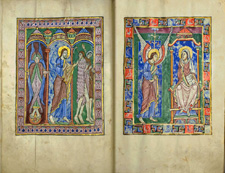Image
© Hildesheim, St Godehard |
THE ANNUNCIATION
Luke 1:28-35
The Virgin sits in an edicule, looking up in surprise from the open book
which she was reading. Its pages, ruled but unlettered, face the reader.
Elsewhere in the psalter (p72, 294
and many more), where they are accompanied by text, such book pages are
almost always inscribed with lettering by Scribe 3 which suggests that
this book was also intended for letters but the scribe did not work on
this quire. Mary’s right palm faces outwards in a gesture of surprise.
In a book where the majority of faces are shown in profile, busily involved
in their own narrative, Mary’s frontal gaze engages with the viewer.
The dove of the Holy Spirit, issuing from the angel’s mouth on a
visibly exhaled breath, flies towards Mary.
The ‘Reading Annunciate’ is an important iconographic rarity
at this stage in the 12th century, although it becomes more common in
the later middle ages (AP,63,81). In Byzantine depictions, Mary
usually holds a spindle, for weaving the veil of the Temple. The idea
of the Virgin reading is found in Pseudo-Matthew where, during her youth
in the Temple she ‘excelled in devout reading and chanting the psalms’.
In Bible commentaries, both Ambrose and Bede mention that Mary had read
about the prophecy that a virgin would conceive and bear a son. Odo of
Cluny (962-1049), in one of his sermons, asks what the Virgin was doing
when the angel came and suggests that perhaps she was reading the prophets.
By the 12th century, Ailred of Rievaulx firmly states in a sermon that
Mary was reading the book of Isaiah at the time.
She is shown with an open book on a lectern, carved on the 9th-century
Brunswick casket, and painted in the 10th –century Benedictional
of St Aethelwold (London, British Library, MS. Add.49598). In the Cluny
Lectionary and Bohemian Coronation Gospels she has a closed book on her
lap but the open book in her lap is new in the St Alban’s Psalter
(AP, pl 118). This innovation corresponds with what is known about Christina:
her psalter ‘lay open on her lap at all hours of the day for her
use’ (Talbot, 1998, 99). Emphasis on the active, intellectual awareness
of Mary is also connected with the cult of the Virgin in the early 12th
century, strongly promoted by Abbot Anselm of Bury St Edmunds, Eadmer
of Canterbury and Osbert of Clare, all of whom were known to the St Albans
Psalter artist.
The dove, an essential element of later Annunciations, is very rare at
this date, being found in the Bohemian Coronation Gospels, 1085 (Prague,
Univ. Lib. MS. XIV A 13/1; AP,67). However the dove appeared before Christina’s
own birth. It flew over from Huntingdon Priory and nestled in her mother’s
sleeve, allowing itself to be stroked for seven days during the pregnancy.
This was a sign that Christina would be filled with the Holy Spirit. (Talbot,
1998, 34-5).
Quire 2.
Thread or stitch holes for protective curtain

Click
to enlarge
|
![]()